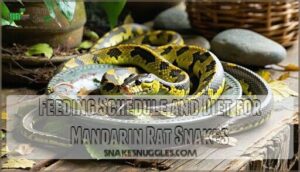This site is supported by our readers. We may earn a commission, at no cost to you, if you purchase through links.

You’ll house them in a 40-gallon terrarium with proper ventilation, UVB lighting, and climbing branches that mirror their rocky forest habitat.
Feed appropriately-sized frozen mice every 5-21 days depending on age, dust with calcium supplements, and maintain their unique environmental needs through daily misting and thermal cycling.
These gentle snakes adapt well to captivity when their specific humidity and temperature requirements are met consistently, allowing them to thrive in conditions similar to their natural habitat at elevations up to 10,000 feet, where they naturally thrive in misty mountain conditions.
The key lies in replicating those misty mountain conditions where they naturally thrive.
Table Of Contents
- Key Takeaways
- Natural Habitat of Mandarin Rat Snakes
- Essential Enclosure Requirements for Mandarin Rat Snakes
- Temperature and Lighting for Mandarin Rat Snakes
- Humidity and Water Needs for Mandarin Rat Snakes
- Feeding Schedule and Diet for Mandarin Rat Snakes
- Handling and Temperament of Mandarin Rat Snakes
- Health Concerns and Common Issues in Mandarin Rat Snakes
- Breeding Mandarin Rat Snakes in Captivity
- Frequently Asked Questions (FAQs)
- How do you care for a mandarin rat snake?
- Should I take my Mandarin rat snake to the vet?
- How do you heat a mandarin rat snake?
- How much humidity do Mandarin rat snakes need?
- Do Mandarin rat snakes need a heat source?
- How to choose a terrarium for a mandarin rat snake?
- Do mandarin rat snakes need a heat lamp?
- What size tank does a Mandarin Rat Snake need?
- What do mandarin rat snakes eat?
- What is the incubation period for mandarin rat snakes?
- Conclusion
Key Takeaways
- You’ll need to maintain cooler temperatures than most pet snakes—create a 72-85°F gradient during the day and drop to 60-70°F at night to mimic their natural mountain habitat.
- Your mandarin rat snake requires 60-80% humidity levels with daily misting and proper ventilation to prevent respiratory issues and ensure successful shedding.
- You’ll house them in a minimum 40-gallon terrarium with climbing branches, dual hiding spots, and UVB lighting to support their semi-arboreal nature and natural behaviors.
- You’ll feed appropriately-sized frozen-thawed mice every 5-21 days depending on age, dusting with calcium supplements every other feeding for optimal nutrition.
Natural Habitat of Mandarin Rat Snakes
Understanding your mandarin rat snake’s natural habitat is essential for creating the perfect captive environment.
These beautiful serpents hail from the cool, mountainous regions of China, Taiwan, Burma, Vietnam, and Tibet, where they’ve adapted to life in rocky forests and farmlands at elevations reaching up to 10,000 feet.
These majestic serpents thrive in China’s misty mountain forests at breathtaking 10,000-foot elevations
Geographic Distribution
Several Asian countries serve as the native range for the Mandarin Rat Snake (Euprepiophis mandarinus), also known as the Chinese Trinket Snake.
This species thrives across diverse biogeographical regions despite ongoing habitat fragmentation challenges.
Their rat snake habitat spans multiple climate zones:
- China’s mountainous regions – Primary native territory with humid forests
- Taiwan’s elevated forests – Dense canopy environments at various altitudes
- Burma and Vietnam – Tropical and subtropical zones
- Tibet’s high plateaus – Extreme altitude effects up to 3,000 meters
- Fragmented forest patches – Adapting to human-modified landscapes
These resilient serpents demonstrate remarkable adaptability to altitude effects, from sea level to mountain peaks.
Preferred Ecosystem and Climate
Your Mandarin Rat Snake calls China’s misty mountains home, thriving in humid forests between 2,000-3,000 meters elevation.
These Climate Zones create perfect conditions with cool temperatures and high Humidity Control.
Geographic Adaptation lets them handle diverse environments from rocky forests to farmlands.
Elevation Effects mean they’re used to temperature gradients and consistent moisture.
Understanding their native humid forests helps you recreate ideal captive conditions with proper humidity levels and temperature gradient management for successful thermoregulation.
Typical Environmental Conditions
At high elevations between 2,000-3,000 meters, these snakes experience unique climate control challenges.
Your captive environment needs proper temperature gradients ranging 68-77°F with humidity management maintaining 65-75% levels.
UVB lighting and proper ventilation prevent mold while supporting natural rhythms.
Key environmental enrichment elements include:
- Temperature zones mimicking mountain conditions
- Humidity levels reflecting their misty forest origins
- Spatial requirements accommodating their active nature
Behavior in The Wild
Wild Hunting Tactics of Mandarin Rat Snakes involve patient ambush strategies in their rocky forest homes.
These skilled predators use Forest Floor Activity patterns, hiding beneath logs and rocks before striking.
Their Burrowing Behaviors help them escape predators and regulate temperature.
Unlike many snake species, Euprepiophis mandarinus shows limited Social Interactions, preferring solitary lifestyles throughout most seasons.
Essential Enclosure Requirements for Mandarin Rat Snakes
Creating the perfect home for your Mandarin rat snake starts with choosing the right enclosure setup.
You’ll need to balance size, materials, and environmental features to keep your snake healthy and comfortable.
This balance is crucial for the well-being of your pet.
Recommended Tank Size and Materials
For ideal reptile housing, your adult Mandarin rat snake needs a spacious 40-gallon terrarium with minimum dimensions of 4ft x 2ft.
Choose PVC or sealed wood over all-glass enclosures for better temperature control and material safety.
These reptile enclosure options prevent condensation issues while supporting bioactive setups.
Consider a 40-gallon reptile terrarium for adequate space.
Proper enclosure size guarantees your snake’s comfort and health.
Importance of Proper Ventilation
Fresh air circulation keeps your Mandarin Rat Snake healthy and comfortable.
Proper ventilation prevents mold growth that can harm your pet’s respiratory health and disrupt humidity levels. Ideal vent placement helps mimic natural airflow.
Here’s why good airflow matters:
- Mold Prevention – Stagnant air creates breeding grounds for harmful fungi
- Air Quality – Clean circulation reduces respiratory infections and shedding issues
- Humidity Control – Balanced airflow maintains optimal moisture without excess buildup
Quality enclosure materials with built-in vents support your snake’s long-term wellness.
Suitable Substrate Options
When selecting substrate for your Mandarin Rat Snake terrarium, think of it as choosing their bedroom flooring.
Coco soil offers excellent humidity retention and supports natural burrowing behavior, making it ideal for Snake Habitat Creation.
Arcadia Earthmix provides superior mold resistance while maintaining moderate moisture levels.
Forest bedding creates the most naturalistic environment but requires careful monitoring.
Consider the substrate product options available to find the best fit.
Aim for 2-3 inches of substrate depth to accommodate digging instincts.
Cost analysis shows coco soil as most economical, while bio-active mixes enhance Mandarin Rat Snake Care through natural decomposition.
Each option supports proper terrarium humidity while preventing bacterial growth in your snake’s living space, which is crucial for proper terrarium humidity and overall snake care.
Necessary Hiding Spots and Enrichment
Your Mandarin Rat Snake needs secure retreats and stimulating activities for peak well-being.
These naturally shy serpents require thoughtful terrarium decoration that supports their burrowing behavior while encouraging exploration.
Hides Importance in Mandarin Rat Snake Care:
- Dual hiding places – Position one hide on each temperature zone for proper thermoregulation
- Climbing branches – Sturdy wood pieces satisfy their semi-arboreal nature and provide vertical habitat creation
- Enrichment schedule rotation – Change decor variety monthly to prevent boredom and stimulate natural behaviors
Temperature and Lighting for Mandarin Rat Snakes
Creating the right temperature and lighting conditions for your Mandarin rat snake replicates their cool mountain habitat and keeps them healthy.
You’ll need to establish a proper thermal gradient with specific heat sources and consider UVB lighting to support their natural behaviors.
Optimal Temperature Gradient
Temperature control acts like a thermostat for your snake’s well-being. Create a proper temperature gradient with a basking spot reaching 82-85°F on the warm side, while maintaining 72-78°F on the cool end.
Your Mandarin rat snake needs this thermal highway for effective thermoregulation. During nighttime drop periods, temperatures should fall to 60-70°F across the entire enclosure.
This mimics their natural mountain habitat perfectly. Use gradient monitoring tools like digital thermometers to track both ends consistently.
Remember, seasonal adjustment isn’t necessary since indoor reptile husbandry maintains stable conditions year-round. Proper temperature control guarantees the best Mandarin rat snake care through consistent heat source management.
Heat Sources and Their Placement
Proper heat sources create the foundation for your snake’s comfort and health.
You’ll need strategic placement to establish effective temperature gradients throughout the enclosure.
- Heat mats go under one side of the tank for consistent belly warmth
- Ceramic emitters provide ambient heat from above the basking area
- Thermostats control all heat sources to prevent dangerous overheating
- Thermal controls maintain steady temperatures day and night
Position heat sources on one end only—this creates the essential temperature gradient your snake needs for proper thermoregulation.
Using the right heat mat products is vital for maintaining ideal temperatures.
UVB Lighting Requirements
Beyond heat sources, you’ll need UVB lighting to keep your snake healthy. Mandarin rat snakes benefit from low-intensity UVB in the 5-7% range.
Position your UVB lighting 11-13 inches above basking spots for ideal UVB intensity. Set photoperiod control for 13 hours during summer, 11 hours in winter.
This lighting cycles approach supports natural behavior patterns. Proper temperature and heating control systems are also vital for maintaining a healthy environment.
| Component | Specification |
|---|---|
| UVB Bulb Type | 5-7% T5 HO strip |
| Distance from Snake | 11-13 inches |
| Daily Photoperiod | 11-13 hours |
Day and Night Temperature Fluctuations
Your UVB lighting sets the stage, but thermal cycling is where the magic happens.
Mandarin Rat Snakes need temperature gradients that mirror their mountain home.
Use heat sources and thermostats for precise temperature control:
- Daytime basking spots: 82-85°F for ideal digestion
- Evening cool-down: Drop to 72-78°F gradually
- Nighttime drops: Allow temperatures to fall to 59-65°F
These natural fluctuations boost metabolism and encourage normal behaviors.
Your snake’s internal clock depends on consistent thermal cycling.
Humidity and Water Needs for Mandarin Rat Snakes
You’ll need to maintain specific humidity levels to keep your Mandarin rat snake healthy and comfortable in captivity.
Getting the moisture balance right prevents shedding problems and creates the cool, humid environment these snakes naturally prefer, which is crucial for their overall well-being and involves maintaining the right humidity levels.
Ideal Humidity Levels
Your snake needs 60-80% humidity to stay healthy.
Think of it as creating a natural rainforest vibe in your terrarium.
Poor humidity causes stuck sheds and stress, while excess moisture invites mold problems.
| Humidity Range | Snake Response | Health Impact |
|---|---|---|
| Below 55% | Dehydration signs | Retained sheds |
| 60-80% | Normal behavior | Healthy growth |
| Above 85% | Respiratory stress | Scale rot risk |
| Shedding period | Seeks moist areas | Complete sheds |
Monitor with digital hygrometers for accurate readings.
Maintaining essential humidity control levels is vital for your pet’s overall health and wellbeing.
Methods for Maintaining Proper Humidity
Since maintaining stable humidity levels requires consistent effort, you’ll need reliable methods that work together seamlessly.
Humidity Control starts with daily Water Misting of your substrate and décor.
Choose moisture-retaining bedding like coco soil or forest mix.
Position your water bowl on the warm side for natural Evaporative Cooling.
Monitor Humidity Levels with a calibrated hygrometer.
- Mist substrate daily, focusing on corners and hiding spots
- Use moisture-retaining bedding like coco soil or cypress mulch
- Add live or artificial moss for natural humidity regulation
- Install Fogging Systems for consistent automated moisture control
Water Bowl Size and Placement
Choose a heavy ceramic water bowl that’s roughly one-third your terrarium’s width for ideal Water Depth and Bowl Placement.
Position this hydration station on the cool side to maintain stable humidity and temperature levels.
Your snake needs easy Snake Access for drinking and occasional soaking.
Clean the water bowl weekly to guarantee excellent Water Quality, preventing bacteria buildup on the substrate underneath.
Misting Frequency and Technique
Proper misting creates the humid environment your Mandarin Rat Snake craves. Daily misting with dechlorinated water maintains ideal humidity levels between 65-75%. Focus your spray technique on substrate and décor rather than directly on your snake.
Here’s your misting game plan:
- Morning mist sessions – Start each day with light, even coverage across the terrarium
- Evening humidity boost – Add extra moisture when temperatures drop for nighttime comfort
- Substrate saturation check – Verify bedding stays slightly damp but never waterlogged
Monitor humidity levels with a reliable hygrometer and adjust your misting frequency accordingly.
Feeding Schedule and Diet for Mandarin Rat Snakes
Getting your Mandarin rat snake’s diet right is essential for their health and longevity.
You’ll need to understand proper prey sizes, feeding schedules, and preparation methods to keep your snake thriving.
Appropriate Prey Items and Sizes
Your carnivorous Mandarin Rat Snake thrives on frozen-thawed mice as their primary diet.
Rodent Selection matters – juveniles need pinkie or fuzzy mice, while adults require large or extra-large mice.
Prey Size Guidelines suggest matching the rodent’s width to your snake’s thickest body section.
Use feeding tongs for safety during meals.
Feeding Frequency for Different Age Groups
Your snake’s appetite changes dramatically as it grows. Hatchling diet needs frequent meals every 5-7 days for rapid development.
- Neonates: Feed every 5-7 days with appropriately sized pinkie mice
- Juveniles: Switch to weekly feeding (7-10 days) as growth continues
- Sub-adults: Reduce to every 10-14 days when metabolism slows
- Adults: Feed every 14-21 days for maintenance nutrition
- Seasonal adjustments: Expect reduced appetite during winter brumation periods
Monitor body condition closely – these feeding schedules support healthy growth stages in your carnivorous companion.
Proper Prey Preparation Techniques
How do you make certain your frozen-thawed mice are safe for your snake? Use feeding tongs to offer prey and avoid accidental bites while stimulating natural hunting behavior.
| Prey Storage | Thawing Methods | Feeding Tools |
|---|---|---|
| Freeze rodents properly | Thaw in fridge overnight | Use feeding tongs always |
| Label with dates | Warm to room temperature | Keep tools clean |
| Rotate stock regularly | Never microwave prey | Have backup tongs |
| Store in sealed bags | Check internal temperature | Sanitize after use |
| Use within 6 months | Pat dry before feeding | Replace worn tools |
Avoid feeding during shedding periods to prevent stress.
Dust prey with Repashy Calcium Plus LoD every other feeding for proper supplementation timing.
Always make certain rodent sizing matches your snake’s girth for safe consumption.
Supplementation Requirements
Now that you’ve got prey prep down, let’s talk supplements. Most Mandarin Rat Snakes get everything they need from whole prey, but smart keepers add insurance.
Your snake’s nutrient balance stays rock-solid with these simple steps:
- Dust prey with calcium supplements every other feeding
- Use Repashy Calcium Plus LoD monthly for vitamin needs
- Gut-load feeders 24 hours before offering
- Monitor mineral requirements through regular vet checkups
Understanding proper snake species diet is vital for maintaining healthy health in your pet, see more at snake species diet.
Handling and Temperament of Mandarin Rat Snakes
Understanding your Mandarin rat snake’s temperament is essential for building trust and ensuring safe interactions.
These naturally shy serpents require patience and gentle handling techniques to thrive in captivity without experiencing unnecessary stress, which is crucial for their well-being and your safety, emphasizing the importance of gentle handling.
General Disposition and Behavior
The Mandarin Rat Snake personality makes them fantastic companions for keepers of all experience levels.
Their docile nature and rare aggression make them a great choice, though they’ll musk when frightened or handled roughly.
Their behavioral traits include frequent burrowing and hiding, which helps them feel secure in captivity.
Social interaction isn’t their strong suit—they prefer solitude over companionship.
Stress factors like excessive handling can trigger feeding refusal, so respect their need for space.
Environmental adaptation comes naturally to this species, making Mandarin Rat Snake care relatively straightforward for dedicated owners.
Safe Handling Techniques
Start by moving slowly and letting your snake see you coming. Gentle handling begins with confidence—nervous energy travels down your arms faster than you’d think.
Support your Mandarin Rat Snake about one-third down its body, avoiding the head region entirely. Keep movements smooth and predictable.
These snake handling techniques reduce stress naturally. Your calm demeanor becomes their calm demeanor through proper stress reduction methods.
Frequency and Duration of Handling Sessions
Once you’ve mastered safe handling techniques, the next step involves finding the right balance for interaction frequency. Your Mandarin Rat Snake needs regular contact to stay socialized, but overdoing it can backfire spectacularly.
Begin with brief 5-10 minute sessions twice weekly for new snakes. Watch their body language carefully during these early interactions. As comfort levels increase, extend sessions to 15-20 minutes and bump frequency to 3-4 times per week for adults. Juveniles handle shorter, more frequent sessions better than marathon handling marathons.
Remember these key points about session duration and gentle interaction:
- Your snake’s comfort trumps your schedule – forcing sessions creates trust issues
- Consistency beats intensity – regular short sessions work better than sporadic long ones
- Quality time matters more than quantity – focused, calm interactions build stronger bonds
- Every snake has different tolerance levels – some love attention, others prefer minimal contact
Monitor stress levels throughout each session. Proper taming methods require patience and observation skills.
Signs of Stress and When to Avoid Handling
Your snake’s behavior tells a story. Watch for rapid breathing, excessive hiding, or defensive posturing – these are clear stress signals.
Skip handling during shedding periods and after meals. Environmental enrichment helps reduce anxiety, while proper humidity prevents additional stress.
| Stress Signal | What It Looks Like | When to Avoid Handling | Alternative Action |
|---|---|---|---|
| Rapid breathing | Quick, shallow breaths | Immediately stop | Check temperature/humidity |
| Defensive posturing | S-curve, hissing, striking | Wait 24-48 hours | Review handling techniques |
| Excessive hiding | Won’t emerge for days | Until normal behavior returns | Monitor health closely |
| Post-meal behavior | Visible food bulge | 48-72 hours minimum | Focus on proper digestion |
When observing your snake, it’s crucial to recognize these signs and act accordingly to ensure its well-being, providing a suitable environment that minimizes anxiety and promotes healthy behavior.
Health Concerns and Common Issues in Mandarin Rat Snakes
Keeping your Mandarin rat snake healthy requires watching for specific warning signs and maintaining proper care routines.
Regular monitoring and preventive measures will help you catch potential issues early and guarantee your snake thrives for its full 15-20 year lifespan.
Signs of Illness to Watch For
Keeping your Mandarin Rat Snake healthy means watching for warning signs.
Respiratory issues like wheezing or mouth breathing signal trouble.
Check for skin lesions, unusual swelling, or eye problems like cloudiness.
Feeding refusal lasting two weeks warrants concern.
Watch for muscle weakness, lethargy, or coordination problems.
Monitor your thermometer regularly – wrong temperatures cause many snake health issues.
Trust your instincts when something seems off.
Shedding Process and Potential Problems
During shedding cycles, your Mandarin Rat Snake becomes vulnerable to various complications that require careful monitoring.
Watch for these common Snake Health Issues:
- Stuck shed around eyes creating cloudy spectacles
- Incomplete shedding leaving patches of old skin
- Dysecdysis from improper humidity levels
Shedding Techniques involve maintaining ideal temperature and humidity.
Scale Issues often stem from dehydration or poor environmental conditions.
Monitor closely during pre-shed periods when your snake’s eyes turn milky blue.
Understanding snake shedding problems is vital for providing proper care and preventing health issues in your pet.
Parasites and Their Prevention
Beyond shedding complications, parasites pose serious threats to your Mandarin Rat Snake’s health.
Internal parasites like roundworms cause weight loss and regurgitation, while external parasites such as snake mites appear as tiny moving dots.
Preventive measures include quarantining new animals and conducting regular fecal examinations.
Deworming methods should follow veterinary guidance for this herpetological species.
Monitor your snake’s feeding requirements closely, as parasites often affect animal nutrition.
Proper animal health protocols protect against both internal and external threats, ensuring your species profile remains robust through consistent preventive care practices, which involve regular fecal examinations and veterinary guidance to prevent issues like weight loss and ensure overall herpetological well-being.
Importance of Regular Veterinary Check-ups
Your Mandarin Rat Snake’s health depends on regular veterinary care with an exotic animal specialist.
Annual checkups help catch problems before they become serious health issues. Schedule these visits even when your snake appears healthy.
During veterinary visits, your vet will:
- Health Monitoring – Check body condition and weight
- Parasite Control – Screen for internal and external parasites
- Disease Prevention – Identify early illness signs
- Animal Nutrition – Review feeding schedule and dietary needs
This proactive approach guarantees your snake enjoys superior animal health throughout its 15-20 year lifespan.
Breeding Mandarin Rat Snakes in Captivity
Breeding Mandarin rat snakes requires careful attention to sex determination and creating the right environmental conditions for successful reproduction.
You’ll need to understand the specific requirements for incubating eggs and caring for delicate hatchlings to guarantee healthy offspring.
Determining Sex and Reproductive Maturity
Determining your Mandarin Rat Snake’s sex starts with observing tail length and body size. Males typically have longer, more tapered tails, while females appear stockier with shorter tails.
However, these visual cues aren’t foolproof—professional probing or DNA testing provides accurate Gender Identification for Breeding Mandarin Rat Snakes.
| Method | Accuracy | Risk Level |
|---|---|---|
| Visual comparison | Low | None |
| Tail measurements | Moderate | None |
| Professional probing | High | Low |
| DNA testing | Highest | None |
| Behavioral observation | Variable | None |
Reproductive Cycles begin around 2-3 years old, with mature snakes showing distinct Breeding Behavior during cooler months.
Creating Optimal Breeding Conditions
Once you’ve confirmed your snakes’ sexes and maturity, setting up proper breeding conditions becomes your next priority.
Success requires precise environmental control and careful timing. Understanding the brumation process is vital for achieving the best results.
Breeding Cycles require these key conditions:
- Temperature Control – Implement 3-month brumation at 52-57°F, then gradually warm to normal levels
- Captive Breeding setup – Maintain 80-90% humidity with proper ventilation and UVB lighting during mating season
- Mating Techniques – Introduce pairs after post-brumation recovery with multiple supervised sessions
- Genetic Diversity – Select unrelated breeding stock to guarantee Egg Fertility and healthy offspring through proven Incubation Methods
Egg Incubation Methods and Requirements
Your breeding success depends on getting the incubation right.
Set your thermostat to maintain steady temperatures between 78-82°F using a reliable heat mat.
Keep humidity at 80-90% by misting vermiculite substrate regularly.
Turn eggs weekly to prevent embryo adhesion.
Create stable hatching environments in proper brooding boxes with consistent temperature control throughout the 60-day incubation period.
Care for Hatchlings and Juveniles
After your eggs hatch successfully, you’ll need to create a nurturing environment for these delicate neonates.
Set up smaller enclosures with appropriate substrate and maintain higher humidity levels than adults require.
Pinkie mice every 5-7 days will fuel their juvenile development perfectly.
Monitor their growth carefully and watch for proper feeding responses during this critical neonate care period.
Frequently Asked Questions (FAQs)
How do you care for a mandarin rat snake?
You’ll need a 4×2-foot enclosure with temperatures ranging 70-82°F during day, dropping to 59°F at night.
Provide hiding spots, maintain proper humidity, and feed frozen-thawed mice every 1-2 weeks depending on age.
Should I take my Mandarin rat snake to the vet?
Yes, you should schedule annual vet check-ups for your Mandarin rat snake to monitor overall health and detect parasites early.
Regular veterinary care helps catch potential issues before they become serious problems.
How do you heat a mandarin rat snake?
Mandarin rat snakes need a precise 70-82°F temperature gradient during the day. You’ll create this using under-tank heat mats and ceramic heat emitters for consistent warmth throughout their enclosure.
How much humidity do Mandarin rat snakes need?
Maintaining proper humidity levels creates a comfortable environment for your snake’s health and successful shedding.
You’ll want to keep humidity between 50-60%, monitoring daily with a reliable hygrometer to prevent respiratory issues, ensuring a healthy environment for your snake.
Do Mandarin rat snakes need a heat source?
Your snake absolutely requires a heat source to thrive.
Create a temperature gradient from 70-82°F using under-tank heating pads and ceramic heat emitters, then drop nighttime temperatures to around 59°F.
How to choose a terrarium for a mandarin rat snake?
Despite seeming simple, choosing the right terrarium involves balancing space, ventilation, and materials.
You’ll need a minimum 48"x24"x24" enclosure with plastic, wood, or glass-wood construction—avoiding all-glass designs for proper airflow.
Do mandarin rat snakes need a heat lamp?
You don’t necessarily need a heat lamp for your mandarin rat snake.
Under-tank heat mats and ceramic heat emitters work better, providing consistent warmth without harsh lighting that might stress these naturally shy serpents, which is a key aspect of their care, involving consistent warmth.
What size tank does a Mandarin Rat Snake need?
Picture your Mandarin rat snake gracefully exploring its spacious home, weaving through branches and hiding spots.
You’ll need a minimum 4×2-foot enclosure for adults, providing ample room for this active species to display natural behaviors and thrive comfortably.
What do mandarin rat snakes eat?
You’ll feed your mandarin rat snake frozen-thawed mice every 1-2 weeks, adjusting prey size as they grow. Juveniles eat weekly, while adults prefer every 7-10 days with occasional calcium dusting.
What is the incubation period for mandarin rat snakes?
Mandarin rat snake eggs typically incubate for 60-75 days at temperatures around 78-82°F with high humidity.
You’ll need to maintain consistent conditions and monitor carefully, as temperature fluctuations can affect hatching success rates substantially.
Conclusion
Successfully caring for your mandarin rat snake isn’t rocket science—it’s simply mountain science! You’ve learned the essential elements of this thorough mandarin rat snake care sheet: maintaining cool temperatures, proper humidity, and providing climbing opportunities.
Remember, consistency beats perfection every time. Your snake doesn’t need you to recreate the entire Himalayas overnight.
Start with the basics, monitor your parameters, and adjust gradually. With patience and attention to their unique mountain forest needs, you’ll provide excellent care for your fascinating serpent companion.
- https://www.morphmarket.com/us/c/reptiles/colubrids/mandarin-rat-snakes
- https://www.thesprucepets.com/mandarin-rat-snake-care-guide-1236786
- https://www.flickr.com/photos/121917432/45803090124
- https://creativecommons.org/licenses/by-nc-sa/2.0/?ref=openverse
- https://reptilesupply.com/blogs/snake-care-sheets/how-to-care-for-your-mandarin-rat-snake



















